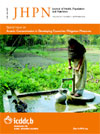
|
The Journal of Health, Population and Nutrition
icddr,b
ISSN: 1606-0997
EISSN: 1606-0997
Vol. 36, No. 1, 2017, pp. 1-12
|
 Bioline Code: hn17037
Bioline Code: hn17037
Full paper language: English
Document type: Research Article
Document available free of charge
|
|
|
The Journal of Health, Population and Nutrition, Vol. 36, No. 1, 2017, pp. 1-12
| en |
Utilization of health facilities and predictors of health-seeking behavior for under-five children with acute diarrhea in slums of Addis Ababa, Ethiopia: a community-based cross-sectional study
Adane, Metadel; Mengistie, Bezatu; Mulat, Worku; Kloos, Helmut & Medhin, Girmay
Abstract
Background: Information on health-seeking behavior and utilization of health facilities in slums of Addis Ababa is
scarce, impeding the implementation of effective interventions. The purpose of this study is to assess the status of
health facilities utilization and predictors for health-seeking behavior of mothers/caregivers of under-five children
with acute diarrhea in slums of Addis Ababa, Ethiopia.
Methods: A community-based cross-sectional study design was employed in five rounds of surveys in seven kebeles
in slums of Addis Ababa among 472 mothers/caregivers of 472 under-five children with acute diarrhea in reference
to Andersen’s behavioral model. Data were entered into EpiData Version 3.1 and analyzed using STATA Version 14.0.
Descriptive statistics were used to examine patterns of health facilities utilization and multivariable logistic regression
analysis was applied to identify predictors associated with health-seeking behavior.
Results: Most mothers/caregivers (70.8%) sought care either at home (14.2%) or health facilities (56.6%), whereas 29.2%
reported that they did not seek any care. Of those who consulted health facilities, government health facilities (76.9%) were
more utilized than private (18.0%) and informal (5.1%) health facilities. Nearly all (93.9%) of the mothers/caregivers using
government health facilities used health centers, and of those who took their children to private health facilities (60.9%)
used clinics and 26.1% used pharmacies/drug vendors. Mothers/caregivers visiting health facilities obtained mainly oral
rehydration salt (ORS) (39.8%) and home-recommended fluids (HRF) (40.3%), but few of them (11.9%) obtained ORS plus
zinc supplementation. Predisposing factors of literacy of mothers/caregivers (adjusted odds ratio (AOR) = 2.4; 95% CI 1.4–4.
1) and occupation (AOR = 2.6; 95% CI 1.5–4.6), the enabling factors of households monthly income of 50 United States
Dollars (US$) and above (AOR = 2.9; 95% CI 1.5–5.6) and availability of nearest health facilities within 15 min walking
distance (AOR = 3.3; 95% CI 1.7–6.6), and the need factors of recognizing danger signs of fever (AOR = 4.3; 95% CI 2.4–7.6)
and vomiting (AOR = 3.3; 95% CI 1.8–5.9) were significantly associated with health-seeking behavior.
Conclusions: Increasing the proximity of health facilities in slums and health education and socioeconomic development
programs targeting illiterate mothers/caregivers and poor households may promote and increase health-seeking behavior
and the accessibility of health facilities for the treatment of acute diarrhea in under-five children in Addis Ababa slums.
Keywords
Andersen behavioral model; Enabling factor; Health-seeking behavior; Health facilities; Mothers/caregivers; Need factor; Predisposing factor; Under-five children
|
| |
© Copyright 2017 - The Author(s)
Alternative site location: http://www.jhpn.net
|
|
